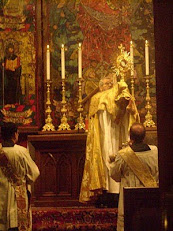 |
| Archbishop Jose H. Gomez of Los Angeles, after receiving the pallium from Pope Benedict XVI in 2011. |
The list of Archbishops who will receive the pallium this year is an impressive display of the universality of the Church. This list was taken from the Vatican Information Service's daily bulletin.
METROPOLITAN ARCHBISHOPS WHO WILL RECEIVE THE PALLIUMVatican City, 25 June 2013 (VIS) – Pope Francis will impose the pallium upon the following metropolitan archbishops in this year's ceremony on 29 June, the Solemnity of Sts. Peter and Paul:
1. Patriarch Manuel Jose Macario do Nascimento Clemente, patriarch of Lisbon, Portugal
2. Archbishop Dieudonne Nzapalainga, C.S.Sp., of Bangui, Central African Republic
3. Archbishop Carlo Roberto Maria Redaelli of Gorizia, Italy
4. Archbishop Claudio Dalla Zuanna, S.C.I., of Beira, Mozambique
5. Archbishop Prakash Mallavarapu of Visakhapatnam, India
6. Archbishop Antonio Carlos Altieri, S.D.B., of Passo Fundo, Rio Grande do Sul, Brazil
7. Archbishop Marek Jedraszewski of Lodz, Poland
8. Archbishop Philip Tartaglia of Glasgow, Scotland, Great Britain
9. Archbishop Salvatore Joseph Cordileone of San Francisco, California, USA
10. Archbishop Rolando Joven Tria Tirona, O.C.D., of Caceres, Philippines
11. Archbishop Rogelio Cabrera Lopez of Monterrey, Nuevo Leon, Mexico
12. Archbishop Joseph William Tobin, C.Ss.R., of Indianapolis, Indiana, USA
13. Archbishop Carlos Maria Franzini of Mendoza, Argentina
14. Archbishop Lorenzo Ghizzoni of Ravenna-Cervia, Italy
15. Archbishop George Antonysamy of Madras and Mylapore, India
16. Archbishop Anil Joseph Thomas Couto of Delhi, India
17. Archbishop John Wong Soo Kau of Kota Kinabalu, Malaysia
18. Archbishop Murray Chatlain of Keewatin-Le Pas, Manitoba, Canada
19. Archbishop Sérgio Eduardo Castriani, C.S.Sp., of Manaus, Amazonas, Brazil
20. Archbishop Peter Loy Chong of Suva, Fiji Islands
21. Archbishop Alfonso Cortes Contreras of Leon, Guanajuato, Mexico
22. Archbishop Alexander King Sample of Portland in Oregon, USA
23. Archbishop Joseph Effiong Ekuwem of Calabar, Nigeria
24. Archbishop Jesus Juarez Parraga, S.D.B., of Sucre, Bolivia
25. Archbishop Fabio Martinez Castilla of Tuxtla Gutierrez, Chiapas, Mexico
26. Archbishop Ramon Alfredo Dus of Resistencia, Argentina
27. Archbishop Mario Aurelio Poli of Buenos Aires, Argentina
28. Archbishop Gintaras Linas Grusas of Vilnius, Lithuania
29. Archbishop Michael Owen Jackels of Dubuque, Iowa, USA
30. Archbishop Duro Hranic of Dakovo-Osijek, Croatia
31. Archbishop Moacir Silva of Ribeirao Preto, Sao Paulo, Brazil
32. Archbishop Jozef Piotr Kupny of Wroclaw, Poland
33. Archbishop Sergio Alfredo Gualberti Calandrina of Santa Cruz de la Sierra, Bolivia
34. Archbishop Giuseppe Petrocchi of L’Aquila, Italy
The following archbishop will receive the pallium in his Metropolitan See:
35. Archbishop Francois Xavier Le Van Hong of Hue, Vietnam.













